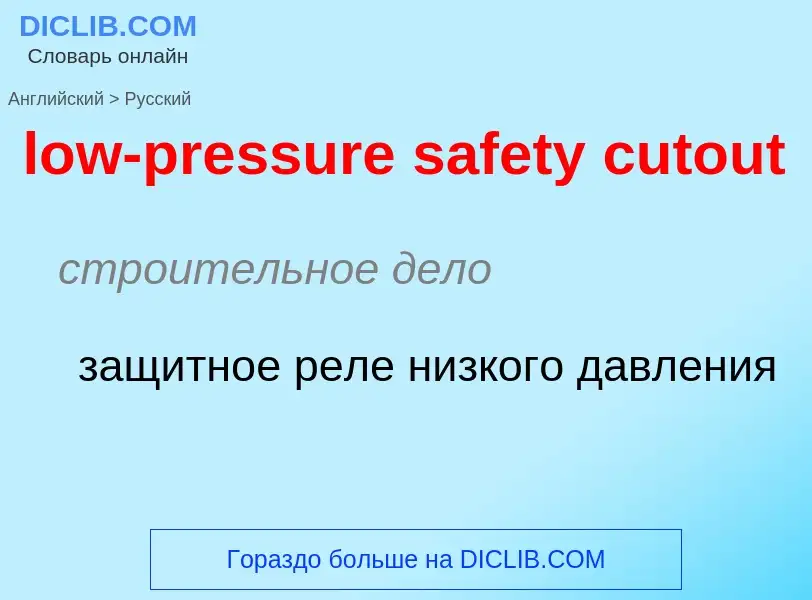Перевод и анализ слов искусственным интеллектом ChatGPT
На этой странице Вы можете получить подробный анализ слова или словосочетания, произведенный с помощью лучшей на сегодняшний день технологии искусственного интеллекта:
- как употребляется слово
- частота употребления
- используется оно чаще в устной или письменной речи
- варианты перевода слова
- примеры употребления (несколько фраз с переводом)
- этимология
low-pressure safety cutout - перевод на русский
строительное дело
защитное реле низкого давления
строительное дело
система отопления низкого давления (водяная, паровая)
общая лексика
низкое давление
медицина
артериальное низкое давление
пониженное давление
медицина
контролируемая гипотензия
управляемая гипотензия
[haipəu'tenʃ(ə)n]
общая лексика
гипотония
медицина
артериальное низкое давление
пониженное давление
существительное
медицина
гипотония
пониженное кровяное давление
Определение
Википедия

In meteorology, a low-pressure area, low area or low is a region where the atmospheric pressure is lower than that of surrounding locations. Low-pressure areas are commonly associated with inclement weather (such as cloudy, windy, with possible rain or storms), while high-pressure areas are associated with lighter winds and clear skies. Winds circle anti-clockwise around lows in the northern hemisphere, and clockwise in the southern hemisphere, due to opposing Coriolis forces. Low-pressure systems form under areas of wind divergence that occur in the upper levels of the atmosphere (aloft). The formation process of a low-pressure area is known as cyclogenesis. In meteorology, atmospheric divergence aloft occurs in two kinds of places:
- The first is in the area on the east side of upper troughs, which form half of a Rossby wave within the Westerlies (a trough with large wavelength that extends through the troposphere).
- A second is an area where wind divergence aloft occurs ahead of embedded shortwave troughs, which are of smaller wavelength.
Diverging winds aloft, ahead of these troughs, cause atmospheric lift within the troposphere below as air flows upwards away from the surface, which lowers surface pressures as this upward motion partially counteracts the force of gravity packing the air close to the ground.
Thermal lows form due to localized heating caused by greater solar incidence over deserts and other land masses. Since localized areas of warm air are less dense than their surroundings, this warmer air rises, which lowers atmospheric pressure near that portion of the Earth's surface. Large-scale thermal lows over continents help drive monsoon circulations. Low-pressure areas can also form due to organized thunderstorm activity over warm water. When this occurs over the tropics in concert with the Intertropical Convergence Zone, it is known as a monsoon trough. Monsoon troughs reach their northerly extent in August and their southerly extent in February. When a convective low acquires a well-hot circulation in the tropics it is termed a tropical cyclone. Tropical cyclones can form during any month of the year globally but can occur in either the northern or southern hemisphere during December.
Atmospheric lift will also generally produce cloud cover through adiabatic cooling once the air temperature drops below the dew point as it rises, the cloudy skies typical of low-pressure areas act to dampen diurnal temperature extremes. Since clouds reflect sunlight, incoming shortwave solar radiation decreases, which causes lower temperatures during the day. At night the absorptive effect of clouds on outgoing longwave radiation, such as heat energy from the surface, allows for warmer night-time minimums in all seasons. The stronger the area of low pressure, the stronger the winds experienced in its vicinity. Globally, low-pressure systems are most frequently located over the Tibetan Plateau and in the lee of the Rocky mountains. In Europe (particularly in the British Isles and Netherlands), recurring low-pressure weather systems are typically known as "low levels".



![This depiction of the [[Hadley cell]] shows the process which sustains low-pressure areas. Diverging winds aloft allow for lower pressure and convergence at the Earth's surface, which leads to upward motion. This depiction of the [[Hadley cell]] shows the process which sustains low-pressure areas. Diverging winds aloft allow for lower pressure and convergence at the Earth's surface, which leads to upward motion.](https://commons.wikimedia.org/wiki/Special:FilePath/HadleyCross-sec.jpg?width=200)
![A low-pressure system over [[Iceland]]. A low-pressure system over [[Iceland]].](https://commons.wikimedia.org/wiki/Special:FilePath/Low pressure system over Iceland.jpg?width=200)
![Megi]], at its peak intensity Megi]], at its peak intensity](https://commons.wikimedia.org/wiki/Special:FilePath/Megi 2010-10-18 0235Z.jpg?width=200)
![[[QuikSCAT]] image of typical extratropical cyclones over the ocean. Note the maximum winds on the poleward side of the [[occluded front]]. [[QuikSCAT]] image of typical extratropical cyclones over the ocean. Note the maximum winds on the poleward side of the [[occluded front]].](https://commons.wikimedia.org/wiki/Special:FilePath/Quikscatcyclone.jpg?width=200)
 patient getting her blood pressure checked.png?width=200)
